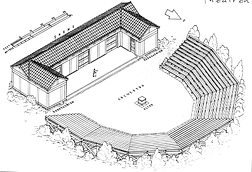 |
| Greek Theater |
Theater was popular with the ancient Greeks and Romans; the Greeks even invented Deus ex Machina (god from the machine), which allowed actors playing gods to enter or exit a scene using a crane. Greek plays were “performed in an outdoor theater, used masks, and were almost always performed by a chorus and three actors.”1 Greek theaters were performed in outdoor theaters, amphitheaters with an orchestra (a dancing space literally, this was a large circular floor where the performance took place) and a skene or set which could be decorated like palaces or temples and used for entrances and exits. Actors could also enter, via crane, from the roof of the skene. The amphitheater also had padodos, or wings, for the actors to enter and exit from. These theaters gradually evolved from the late 6th century BC through the 3rd century BC.
 |
| Greek Theater Drawing |
 |
| Model for a Roman Theater |
The first Roman theater was built in 54 AD and was similar to the Greek theater. The Orchestra became a half circle, though, and the skene became a scaena (this would later be the word scene) which joined the stadium-style audience seating. A proskene (proscenium) was the area in front of the scaena. This looks roughly like modern theaters: a stage with an apron and a background and audience seating from one side to the other. The Roman stage was raised and given more doors while porticoes were developed and dressing rooms became popular. Trap doors were also common and theaters arranged for awnings to cover the audience from the sun.2 While Rome had appropriated theater from the Greeks, when Rome became Christian around the 6th century AD, theater was opposed by the church. The last recorded performance in Rome took place in 533 AD and when Rome actually fell, theater fell with it.3
| Roman Theater Ruins |
The Greeks and Romans significantly contributed to the technology of the theater. They established a theater, giving it an acoustically well-designed shape and an easily visible playing space. The Greek developed Deux ex Machina and basic sets while the Romans added buildings, prosceniums, trap doors, and dressing rooms to theaters. The technology of deux ex machina and the trapdoor would have led to some very interesting and magical scenes being staged. These would all be employed when theaters again were used, in the early 1500’s.
1 Walter Englert. “Staging an Ancient Greek Play.” Ancient Greek Theater. http://academic.reed.edu/humanities/110tech/theater.html#origins. (Accessed July 20, 2011).
2 Eric W. Trumbull. “Roman Theatre Design—Buildings.” Roman Theatre and Drama. http://novaonline.nvcc.edu/eli/spd130et/roman.htm#roth (Accessed July 20, 2011).
3 Eric W. Trumbull. “Theater at the End of the Empire.” Roman Theatre and Drama. http://novaonline.nvcc.edu/eli/spd130et/roman.htm#roth (Accessed July 20, 2011).
Photo Credits:
Greek Theater Drawing: http://www.geneseo.edu/~blood/OutGreek.html
Roman Theater Model: http://www.vroma.org/~bmcmanus/leisure.html
Roman Theater Ruins: http://www.h4ppy.com/blog/2006/04/sabratha-part-of-ancient-roman.html
No comments:
Post a Comment